Next month marks the 40th anniversary of the first installment in Roberta Williams’ King’s Quest series. A series that would herald the graphical adventure game up through the ’80 and most of the ’90s and define Sierra On-Line as the software entertainment powerhouse we all would come to love. This is the first part in the series telling the King’s Quest story.
Something was out of the ordinary at the new corporate headquarters of Sierra On-Line in the small town of Oakhurst, California. While Ken and Roberta Williams‘ software company, far away from the bustling technological hubs of San Francisco and Silicon Valley, to many locals was shrouded in mystery, amidst the usual comings and goings of casual jeans and t-shirt-wearing employees conspicuously men dressed in dark, three-piece suits with suitcases started making appearances.
The Williamses company, initially named On-Line Systems, had earlier in 1982 secured a significant infusion of investment capital, over a million dollars, when financial wizard Jacqueline Morby, managing director at prestigious TA Associates, acquired a 24% stake in the company. With the influx of venture capital, the company more or less resembling a hacker summer camp, was evolving into a structured and legitimate business. The money was put into new management, better research, development, marketing, and manufacturing facilities. Recognizing the need for a distinctive identity, the company, now located in the scenic foothills of the majestic Sierra Nevada Mountains near Yosemite National Park, adopted the name Sierra On-Line with the iconic landmark, Half Dome Mountain as its logo.
Sierra On-Line’s new headquarters consisted of a series of offices within the same building that housed the local utility payment office for Oakhurst and nearby Coarsegold, alongside a ground-floor furniture store and a beauty parlor adjacent to Ken’s marketing and advertising office. On several occasions serious-looking corporate-clad men were seen in the vicinity of the headquarters. These were clearly not tourists visiting the sites in the area, but representatives of mighty IBM, one of the largest and most important companies in U.S. business history.
The delegations, unannounced, were to inspect the headquarters, filtering through wastebaskets for documents stamped ”Confidential,” checking metal security measures on filing cabinets, and testing the locks on the door to a special, isolated room with shrouded windows. Inside, Sierra programmers were toiling with an IBM treasure, a prototype of the company’s secret and upcoming affordable entry into the home computer market. Ken and IBM already had a solid working relationship and now his company had been hired, in advance of the public unveiling, to develop a game that would take full advantage of the machine’s extended graphics and sound capabilities.
In typical IBM fashion confidentiality was paramount and everything was to be kept top secret. IBM forbade direct reference to the company by its name, instead, a code name was devised, with Ken creatively labeling it “BFC”, “B” for big, “F” for …, and “C” for company. In any correspondence from that era, the code name “BFC” discreetly masked any direct reference to IBM and while only a few select employees were to know about the top-secret project, the word quickly spread throughout the headquarters.
Back in the summer of 1980, IBM executives had given the go-ahead to Bill Lowe, the director of the IBM General Systems Division lab at the company’s Boca Raton, Florida, facilities to set up a task force and develop the proposal for a computer for small businesses and consumers that would sell for $1,500. The task force was fighting IBM’s bureaucratic culture and the idea that things couldn’t be done quickly within the company with one analyst quoted as saying “IBM bringing out a personal computer would be like teaching an elephant to tap dance.”
During a meeting with top executives in New York, Lowe claimed his group could develop a small, capable computer within a year. The response was “You’re on. Come back in two weeks with a proposal.”
Lowe picked a group of 12 strategists who worked around the clock to hammer out a plan for hardware, software, manufacturing setup, and sales strategy. Don Estridge, acting lab director at the time, volunteered to head the project and got permission to run a skunkworks entirely outside of IBM’s standard procedures. Estridge decided early on that to succeed and meet deadlines, the group had to stick to the plan of using tested vendor technology, a standardized one-model product, open architecture, and outside sales channels as the company had no retail experience. IBM turned to ComputerLand, Sears, Roebuck and Co., and IBM Product Centers to make the computer available to the broadest set of customers.
Pursuing expertise in home computer software, IBM sought an individual with a deep understanding of the market and a proven track record in software development. Turning to one of the most accomplished figures in the industry, Ken Williams emerged as the natural choice. His company had consistently been at the forefront of personal computer software, boasting an impressive portfolio of successful titles that included pioneering graphical adventures and an array of fast-paced action games. Williams, in contrast to many in the home computer business, brought a unique background from the corporate mainframe world, a domain that IBM dominated and understood intimately. He was a prodigious programmer with a savvy business mindset, resonating well with corporate IBM, making him the ideal candidate for its take on the home computer software market.
On August 12, 1981, Estridge unveiled the IBM PC at New York’s Waldorf Hotel. Priced at USD 1,565, it had 16 kilobytes of RAM and no disk drive. To add a display, a diskette drive, and a printer the price doubled to $3,000, equivalent to over $10,000 in today’s money.
Don Estridge, the father of the IBM PC, was charged with developing IBM’s foray into the home computer market and having a computer ready for sale in just one year.
Image: ibm.com
The first shipments of the IBM PC began in October 1981 but even before its release reviewers had been impressed by the advertised specifications of the machine, and upon its release reviews praised virtually every aspect of its design both in comparison to contemporary machines and with regards to new and unexpected features. Sales would exceed IBM’s expectations by as much as 800% and at the peak, machines were selling at a rate of one every minute of every business day
IBM wanted into the home and entertainment market but without any experience, contacted Ken Williams, one of the most accomplished in the business. IBM licensed his and Roberta’s Wizard and the Princess, one of the most popular and best-selling Apple II games of the time.
The game was renamed “Adventure in Serenia'” and published by IBM in 1982.
The bland cover showed that corporate IBM had no idea of how engaging consumer packaging was essential for any product to stand out on the shelves, and catch the attention of consumers.
The IBM PC, the lowest-priced IBM computer to date, was an immediate success and one of the reasons Time Magazine chose the Personal Computer as its “1982 Man of the Year” marking the first time that the editors selected a non-human recipient for the award since the award’s inception in 1927.
In late December 1982, Time Magazine awarded “Man of the Year” to the Personal Computer, breaking away from its long tradition of only nominating humans. The magazine hit newsstands at the beginning of January 1983 and helped establish a trend of PCs being an essential appliance for the home.
Despite its immense success, the IBM PC was first and foremost a business machine and to many, too expensive as a home consumer product. Confident, IBM, in 1982, started looking to develop a more affordable home computer intended as a lower-cost variant with hardware capabilities better suited for games and entertainment, to compete more directly in the rapidly growing market with established contenders, like the cheaper offerings from Commodore, Atari, and Apple.
In late 1982 developers started developing software for IBM’s upcoming machine, codenamed “Peanut.” Among those was Sierra On-Line, which had met with a team of suited IBM executives from Florida and asked if they could produce an enhanced version of Adventure in Serenia, as a prominent launch title. Under detailed IBM production outlines and a policy of strictly enforced security, IBM was willing to fund the project, market the game, and pay royalties, but the top-secret project had to break new ground, take full advantage of the systems’ state-of-the-art graphics and sound capabilities, and be replayable. The Williamses accepted IBM’s offer knowing that its forthcoming machine, to become the IBM PCjr, employing a powerful 16-bit processor and, at the time, an unheard-of 128 KB of memory was able to do sophisticated graphics and animation, fulfilling a long-standing desire of Roberta’s, that had been constrained by the limitations of all earlier systems.
The IBM PCjr project within Sierra proved somewhat of a saving grace with IBM paying as milestones were reached. While analysts marked trends of saturation during 1982-83 with consumers losing confidence in a market filled with poor-quality titles, Sierra had channeled substantial resources into the console and cartridge-based gaming market. A risky venture as game cartridges incurred higher production costs and had longer production times than floppy and cassette-based games. With lightning-fast advancements in technology, machines popular today could be obsolete by next month. The span from idea to development, testing, and manufacturing, a designated system could be nothing more than a nostalgic memory of yesterday. Like so many, Sierra soon found itself navigating through a market swerving towards catastrophe, with diminishing returns on investment looming as sales dwindled. The company ended up with millions of dollars in inventory of games that nobody wanted, many produced for the Texas Instrument TI-99, the ColecoVision, and the Commodore VIC-20, systems already deemed obsolete by the time products were hitting shelves.
Burning through the last cash reserves, Sierra was going broke fast, Ken and Roberta maxed out their credit cards and leveraged their home. Their company had to undergo a massive downsizing and in a matter of weeks, over 130 employees turned to less than 35. Simultaneously, as investor confidence wavered in the company’s ability to make money, Sierra’s ideas for the new game, including an animated protagonist and an open world to explore were received with praise by IBM, even so that other products were contracted, including a word processor, enabling Sierra to rehire some of its earlier layoffs.
IBM provided Sierra with a prototype computer, essentially a few circuit boards mounted to a backplate, and under Ken’s watchful eye, Roberta and six designers, artists, and programmers went to work. The success of the project was imperative for the survival of the company and required a collaborative effort from everyone involved to ensure the best possible product was to be delivered to IBM. To realize the ambitious and technically complex animated game, Sierra earlier had sold IBM, a new game engine was imperative, replacing the aging development framework, Ken had written and had been used in the company’s earlier and successful Hi-Res Adventure games.
Leading the overhaul was Arthur Abraham, a brilliant computer scientist who had cut his teeth on Burroughs mainframe systems and had worked on systems for both the USPS and NASA. Abraham was joined by software engineer Charles Tingley. Abraham assumed leadership in the language aspect of the new engine, with Tingley focusing on the development of the underlying graphics components. The primary objective was to foster a more cohesive development environment, enabling artists, designers, and programmers to actively participate in the process, collaborate on work, conduct testing, and more, all within the same system.
The engine comprised a bespoke programming language dubbed the “Game Adaptation Language,” a compiler, and a bytecode interpreter, coming to be known as the “Adventure Game Interpreter.” The Game Adaptation Language, a high-level programming language resembling C, was compiled into bytecode, a low-level representation of the source code, designed to be executed by a virtual machine rather than directly by the computer’s hardware. As bytecode often is platform-independent, it can be executed on any system that has a compatible virtual machine, making development more or less independent of the underlying hardware, a factor that ultimately would prove vital later on.
Ken and brother Doug MacNeill, who a handful of years later, together would create Goldrush!, joined the project. Ken MacNeill, armed with a computer science degree and working as a flight instructor at the Fresno airport, had earlier crossed paths with Ken Williams during his pilot lessons. The two became friends and Williams extended him a job offer for him to come work at his company. MacNeill joined the top-secret IBM project, taking on programming responsibilities and came to play a pivotal role in the overarching game development. Artist Greg Rowland joined the project along with Doug, who was recommended by his brother. Despite lacking any previous computer experience, Doug showcased his artistic skills through a series of sketches and successfully secured his position on the team.
With the team in place, Roberta mapped out her story, with familiar characters from literature, inspired by the stories and fables from the fairy tales and children’s books she so much loved. Once the rather simple storyline had been established and she had described the intentions of the various locations, artists prepared detailed drawings of each of the 48 outdoor and 32 indoor scenes. Each drawing was traced on a Calcomp Graphics Tablet, automatically generating the instructions for the computer to reproduce each drawing as lines and shapes. The vector approach, drawing point by point and then filling in the colors, was essentially the same, as the company had used in its prior adventure games, as storing instructions required much less disk space than storing rasterized images.
The video adapter of the IBM PCjr was capable of displaying an impressive 16 colors simultaneously, a significant leap beyond the ubiquitous four-color limitation of IBM’s CGA or the artifact colors of the Apple II but the colorful and visually stunning possibilities was just one aspect of the groundbreaking impact the final game would come to have. The team aimed to forge a stronger connection between the human player and the protagonist and departed from the first-person perspective used in earlier titles of the genre, which often hindered player immersion. Turning to a third-person perspective with a visible animated protagonist journeying throughout the narrative and open-world fantasy setting, interacting with the environment, objects, creatures, and characters, would offer an unparalleled gaming experience.
In order to create an environment that granted players true freedom of movement, a clever approach was devised of splitting up each scene and its objects into a number of prioritized elements based on their distance to the bottom of the screen. The game engine then seamlessly determined whether the player, relative to his own position, occupied a position behind or in front of objects. The technique created the illusion of three-dimensional depth within the game world. Drawn hidden lines defined walkable areas.
It would typically take the IBM PCjr around four seconds to draw and color-fill a scene.
The opening scene featuring the detailed Castle of Daventry, complete with animated flags and lurking alligators, would be the game’s most intricate and take up 2,400 bytes of instructions.
Predating the advent of true three-dimensional graphics, elements were color-coded depending on their relative depth-position and put into prioritized layers, the game engine then seamlessly determined whether the player occupied a position behind or in front of them.
Navigating through uncharted territory, and adapting to new standards, tools, and workflows presented a challenge but IBM’s specific request for the game to be replayable added another layer of complexity to the game’s design. Unlike competing genres, like role-playing games, where replayability was inherent, adventure games, by nature, were much more linear. The team, to address it, implemented a point system and incorporated multiple solutions to puzzles, with more obvious solutions contributing fewer points to the player’s overall score.
As development progressed, albeit behind schedule, the unveiling of the IBM PCjr to the public in November 1983 sparked significant hype and optimistic projections with numerous contemporary media publications confidently predicting that IBM’s consumer-oriented machine swiftly would come to dominate the home market. Ken Williams, given IBM’s success with its IBM PC, foresaw millions of sold machines with a significant number of buyers considering his company’s new game, now titled King’s Quest, as the must-have launch title.
In late 1983, Abraham left the project, seemingly on bad terms, leaving Tingley to finalize the underlying work required. While production delays had the PCjr missing the crucial Christmas sales season, demonstration machines started to show up in January 1984. The same month, at the Winter CES Show in Las Vegas, Sierra demoed King’s Quest for the first time, just as Roberta finished her final commitments on the game. When the PCjr finally became widely available in March 1984, King’s Quest was still over a month away from release. Throughout its development, the team, particularly the programmers, grappled with persistent delays. Finally, after 18 months of development and a cost of $850,000, predominantly funded by IBM, the game was complete and ready to take the spotlight.
IBM published King’s Quest for its PCjr on May 10th, 1984.
The release included a 36-page manual, a program license agreement, a backup certificate, and a full keyboard overlay which showcased the different keys’ functionality.
IBM’s idea was that each product would have its own overlay, giving the user an easy overview of functionalities and hotkeys. The overlays were also used as a demonstration gimmick for PCjr demo machines.
The cover artwork, unfittingly showing a knight in full armor with a sword, shield, and red-glowing eyes, was commissioned by IBM. The work was done before the game was completed and with the artist only knowing bits and pieces of the game’s story.
King’s Quest granted players unprecedented freedom as they explored the vibrantly animated world teeming with fantasy, intricate puzzles, and a diverse array of characters and creatures.
Sir Grahame, Daventry’s finest knight, is entrusted by the aging King Edward with a vital mission, to recover three stolen magical treasures to ensure the prosperity of the kingdom. The treasures include a mirror capable of revealing the future, an enchanted shield offering protection from harm, and a chest of gold that never runs empty. Successfully completing the quest holds the promise of the throne itself.
The manual with original cartoon artwork, included The King’s Appeal, a short introduction to the game’s story and setting.
Unlike the cover, the included artwork in the manual depicted actual scenes from the game, albeit in the same cartoonish style, used by IBM in its consumer product manuals at the time.
Prior to its release, the anticipation surrounding the IBM PCjr started to wane as fresh details about the machine surfaced, leading to growing concerns among retailers about its true market appeal. The PCjr was notably overpriced at $1,269 for the 128 kb model required to play King’s Quest and faced criticism for deliberate compatibility limitations, a move seemingly aimed at preventing it from competing with IBM’s pricier, more sophisticated models. The system struggled with compatibility with several popular IBM PC programs and it wasn’t until the public unveiling that Sierra knew anything about the machine’s distinctive chiclet keyboard, which IBM had withheld. The keyboard would prove to be one of the computer’s major downfalls.
Ken and Roberta Williams, proudly behind IBM’s affordable entry into the consumer market, running what would become one of the most influential games in computer gaming history. The prototype computer Sierra had received for development had amounted to a few circuit boards mounted to a backplate, it wasn’t until IBM’s public unveiling that details about the IBM PCjr’s aesthetic became known.
Image: historylink.org
After the PCjr became widely available, sales were below expectations. Consumer interest had reportedly been high until demonstration machines became available, at which point interest dropped steeply. Dealers reported that consumers disliked the price, the subpar keyboard, the overall design philosophy, and limited memory, and IBM retailers primarily catering to business customers faced challenges in effectively marketing it.
The press quickly echoed concerns that the PCjr had the potential to become a source of embarrassment for IBM, with executives reportedly expressing apprehension about demand. Stores responded by offering discounts, and vendors scaled back their plans for releasing products compatible with the system. IBM acknowledged that the demand for the PCjr was not expanding as rapidly as anticipated and by May 1984, when King’s Quest was released, IBM had sold a mere 10,000 machines.
IBM had produced some of the best keyboards for its PCs but the small chiclet keyboard that came with the PCjr was more or less unusable for any serious work. It featured 62 keys rather than the 83 of the PC keyboard with the remaining keys requiring the user to hold a modifier key.
Image: theregister.com
King’s Quest, while critically acclaimed for setting new standards in gaming and becoming game of the month, the poor reception of the PCjr subsequently led to disappointing sales. At the end of July 1984, IBM announced a newly designed keyboard, using more conventionally shaped keycaps in a last effort to have it succeed but to no wane. A year later when IBM pulled the PCjr from the market, the computer had already cemented its reputation as one of the most spectacular failures in computing history.
King’s Quest was rereleased in the latter part of 1984.
The full keyboard overlay was replaced by a small strip for use with the newly introduced non-chiclet replacement keyboard.
IBM had been in a legal struggle with the U.S. government for over a decade. Its dominance in the computer industry had led to an anti-trust case, with the government threatening to break up the company. In January 1982 the case was withdrawn on the grounds that it was without merit but it had shaken IBM to its core and affected how the company would do its future business. The Paranoia resulted in IBM being afraid of licensing anything exclusively and along with the non-disclosure agreement Sierra had signed with IBM back in late 1982, IBM had expressively stated that the game could be marketed to other companies.
By 1984, IBM had successfully filled the market with nearly 5 million PCs, complemented by an additional 2-3 million IBM-compatible systems from other manufacturers. The rapidly growing market was unquestionably better suited for a triumphant PC version of King’s Quest, to compensate for the lackluster sales of the PCjr version. At the end of May, only a matter of weeks after the PCjr release, Sierra self-published King’s Quest for the IBM PC. The release featured vastly improved cover art, now skillfully portraying the game and its storyline, and was complemented by a heightened dramatic backstory within the accompanying manual by editor and writer, Annette Childs, who was working in Sierra’s marketing and packaging department.
The initial IBM PC release faced limitations due to only supporting CGA composite mode which required either a composite monitor or NTSC television set hooked up to the CGA card’s composite RCA jack output. Computers at the time were primarily acquired for home office and business work and were commonly sold with RGB monitors, able to display crystal clear text for word processing and other business applications but not the artifact colors of the CGA composite output. IBM’s CGA card only came equipped with 16kb of memory, allowing the maximum number of RGB colors it could output in graphics mode to 4 from the available 16 color palette. The CGA composite requirement catered to a virtually non-existent market.
To become a commercial success on IBM PCs, King’s Quest needed a rework to support the standard IBM 4-color RGB CGA mode, ubiquitous with nearly all PCs at the time. By August 1984, the game had been updated, and a new version was released. This was the first version to feature Chris Iden in the credits. Iden, a software wizard carrying a B.S. with Honors in Computer Science from California Polytechnic State University, would become one of the instrumental forces in iterating and developing the two game engines used in all of Sierra’s subsequent adventure games.
Sales remained sluggish, and Sierra continued to grapple with financial issues. Concurrently, at the January 1984 CES show where King’s Quest was first showcased, Sierra had inked a deal with the Walt Disney Company to develop educational software featuring the entertainment giant’s beloved characters. By mid-1984, faced with disappointing sales figures for King’s Quest, the company reluctantly initiated another round of layoffs in a bid to weather the storm. To sustain operations, resources were redirected predominantly towards the Disney venture, while utilizing the adaptable framework to expand the availability of King’s Quest across other platforms.
Sierra needed the investment put into King’s Quest to pay off better but its scope, while impressive also rendered it incompatible with most computers of the time. The original Apple II, the system that had harbored the company’s early success, supported a maximum of 48kb of memory, and the latest Apple IIe, while upgradeable, was expensive. Commodore‘s latest offering, the Commodore 64, released in 1982 and now the most popular gaming platform, boasted only 64kb. King’s Quest in all its animated glory needed 128kb.
Coinciding with the PCjr release of King’s Quest, Apple Computer unveiled its newest computer, the Apple IIc. The compact, portable, and user-friendly computer hit the market equipped with a standard 128kb memory and became generally well-received, enough so, that it prompted Sierra to task Jeff Stephenson to adapt a version for the system, which followed in October of 1984.
By October of 1984, Sierra published King’s Quest for the Apple IIe/IIc.
Like the first IBM PC releases, the cover featured the tagline “An Animated Game.”
Depicted here, the 1985 Apple IIe/IIc release, with the reworked tagline “An Animated Adventure Game.”
Sierra On-Line announcing the availability of King’s Quest for the IBM PC and Apple II.
1984 magazine advertisement.
During 1984, Ken Williams flew down to Texas to meet with executives from Radio Shack, the largest retailer of electronics in the world with over 6,000 stores across the U.S. Tandy Corporation which owned Radio Shack was working on a new computer, intended to compete with the IBM PCjr. After several meetings with Radio Shack CEO John V. Roach, one of the early proponents of the personal computer, Ken came away with an agreement that the retailer would sell King’s Quest for the upcoming computer.
Back in 1983, Tandy’s share of the market was about half what it had been at its peak in 1979. More notably, its profits, which had been on a steady climb for four years, were leveling off fast. Tandy’s attempt to align with IBM’s trajectory came in November 1983 with the release of its Tandy 2000, a 16-bit MS-DOS computer that like the PCj wasn’t fully IBM PC compatible and never managed to get a serious foothold in the market.
In November 1984, Tandy Corp. introduced its Tandy 1000, the company’s first fully IBM PC-compatible computer. The system offered the same graphics and sound capabilities as the PCjr but came with a proper keyboard, better expandability, was better priced, and with thousands of Radio Shack stores to market and sell it, it was much better equipped for success in the consumer market. In its first month after being introduced, the Tandy 1000 sold more units than any other Tandy product and by early 1985 it was the company’s best-selling computer.
The Tandy 1000 version of King’s Quest was licensed to Tandy Corporation and published in the unique clamshell box in the early summer of 1985 (left). The version would also run on a 128 kb IBM PCjr but not on an IBM PC or compatible. The Clamshell release would only sell for a few months before it was re-released in the standard flip-top box (right).
Versions of King’s Quest for the IBM PC and IBM PCjr were combined and released on September 4, 1985.
The package came with two floppy disks, one for IBM PCs and one exclusively for the IBM PCjr.
In November of 1986, Sierra released the first version of King’s Quest to support IBM’s Enhanced Graphics Adapter, EGA. For the first time, IBM PC owners, those having 256kb of memory and an EGA card, were able to enjoy King’s Quest, as it was intended, in its full 16 colors, albeit still in 160×200 resolution, dictated by the original PCjr release. Support for the standard 16-color EGA 320×200 resolution was only made possible when Sierra introduced a new game engine a few years later.
Based on the 256kb IBM EGA version, Sierra ported King’s Quest to the Commodore Amiga and Atari ST in 1986.
While the adventure game genre previously had explored the incorporation of animations, no one had achieved such a seamless integration in a comprehensive package with the level of quality demonstrated by Roberta and her team. King’s Quest stood out as nothing short of revolutionary and would come to establish an entirely new benchmark for games.
With the development framework tailored for the advanced capabilities of the IBM PCjr and now the equally sophisticated Tandy 1000, Sierra positioned itself as a market leader, delivering enhanced graphics, sound, and animation ahead of the competition. While King’s Quest didn’t achieve commercial success on the IBM PCjr, subsequent releases on other platforms led to substantial sales figures and paved the way for seven sequels. Collectively, these sold nearly 10 million copies establishing Roberta Williams as one of the most successful and influential game designers of all time.
While IBM’s investment in Sierra On-Line, King’s Quest, and a few other products proved a saving hand it was not the sole determinant of the company’s resilience during the challenging times but the legitimacy of the IBM name and the cultivated relationship played a pivotal role in establishing the company as a serious business, occupying a tier that few other companies in the business managed to attain at the time. Ken Williams’ strategic deal with Tandy Corporation to feature King’s Quest as the premier game for its computers in the thousands of Radio Shack stores nationwide resulted in sales soaring and marked the beginning of an impressive 15 years boasting nothing but positive figures on the company’s bottom line.
By 1987, the first three King’s Quest titles had collectively sold more than 500,000 copies.
During the summer, all three titles were re-released in the now iconic Sierra slipcase box.
King’s Quest received the subtitle “Quest for the Crown.”
The in-house prototype development framework crafted to create King’s Quest was iterated over the following years and was employed in all of Sierra’s adventure titles for the remainder of the ’80s. Amid Roberta’s fantasy writings, other designers began harnessing the proven game engine to craft their own adventure game series. Mark Crowe and Scott Murphy‘s Space Quest, Al Lowe‘s Leisure Suit Larry, Jim Walls‘ Police Quest, and Corey and Lori Ann Cole‘s Quest for Glory, all series that achieved immense success, heralding Sierra On-Line into an entertainment behemoth.
By the latter part of the decade, as hardware continued to evolve, Sierra recognized the need for a new development system to allow its products to maintain a competitive edge. Jeff Stephenson, who had led the IBM PCjr word processing project running alongside the production of King’s Quest and who later ported the game for the Apple II, was tasked to develop a new fully object-oriented scripting language, initially dupped the Large-model Script Code Interpreter, LSCI, but soon re-titled to the Sierra Creative Interpreter, SCI.
SCI, first utilized with the fourth installment in the King’s Quest series, “The Perils of Rosella,” released in the Fall of 1988, allowed for more complex animation, 16-color EGA 320×200 resolution graphics, soundcard, and mouse support. Capitalizing on technological strides and armed with a future-proof development framework, Sierra fiddled with the idea of rejuvenating its classic adventure games. While the majority of the company’s resources were dedicated to creating new cutting-edge games, the design and layout of earlier titles were already established. Converting classics into modern renditions seemed a strategic way to capitalize on existing assets, catering to both newcomers and original players seeking a contemporary experience.
In 1990, Josh Mandel, a newly hired junior producer with a background in advertising, acting, and comedy, was tasked with completing the enhanced version of the first King’s Quest title, which by now had been in development for a year. Mandel got permission to rewrite the text, adding a more colorful approach to fit the game’s visuals, as long as he passed any changes to Roberta for her approval. Alterations to some of the game’s puzzles, including the notorious Rumplestiltskin puzzle were made along with some general improvements to the game’s overall design.
In September of 1990, Sierra released an enhanced version of King’s Quest (left), using the first iteration of SCI(0). The graphics were still 16-color EGA but in 320×200 resolution, twice what AGI could deliver.
Just months later, Sierra published King’s Quest V: Absence Makes the Heart Go Yonder! utilizing SCI1 allowing for 256-color VGA and a fully point’n’click interface, rendering the enhanced version of King’s Quest, technically obsolete overnight. Subsequent remakes of the first Space Quest, Leisure Suit Larry, Police Quest, and Quest for Glory titles were all done using SCI1.
In 1991, the enhanced version was re-released with new cover artwork (right).
The enhanced EGA version of King’s Quest looked and played like King’s Quest IV: The Perils of Rosella, released in 1988.
Following the initial IBM PCjr release in May 1984, Roberta had expressed that her envisioned scope for the game exceeded the constraints imposed by available development time and the memory limitations of the PCjr. To fully manifest her vision, she had to create a sequel but that and much more are stories for upcoming articles.
Sources: NY Times, April 1984, IBM, Compute! Magazine February 1985, Wikipedia, Not All Fairytales Have Happy Endings by Ken Williams, jeffstephensonart.com, LinkedIn, celestis.com, sciprogramming.com, Hackers: Heroes of the Computer Revolution by Steven Levy, Software People by Douglas Carlston, The Sierra Adventure by Shawn Mills, Ron White – 80 Micro magazine, August 1987, Sierra News Magazine spring 1990, Sierra Collector’s Quest by Stephen Emond, Nerdly Pleasure, Sierra News Magazine Spring & Fall 1990, Video Game Newsroom Time Machine – Interview with Jeff Stephenson, Adventure Classic Gaming – Interview with Josh Mandel…





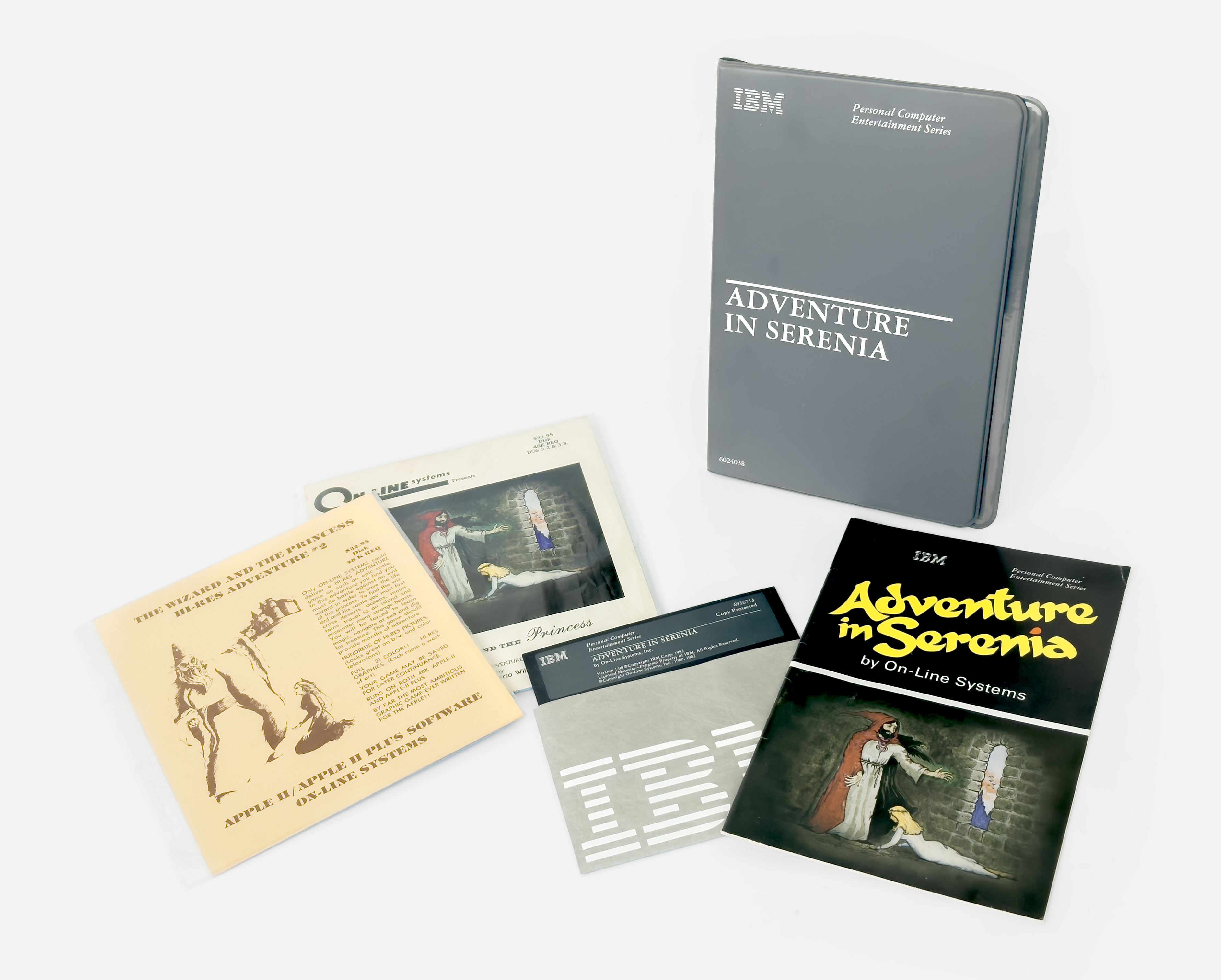

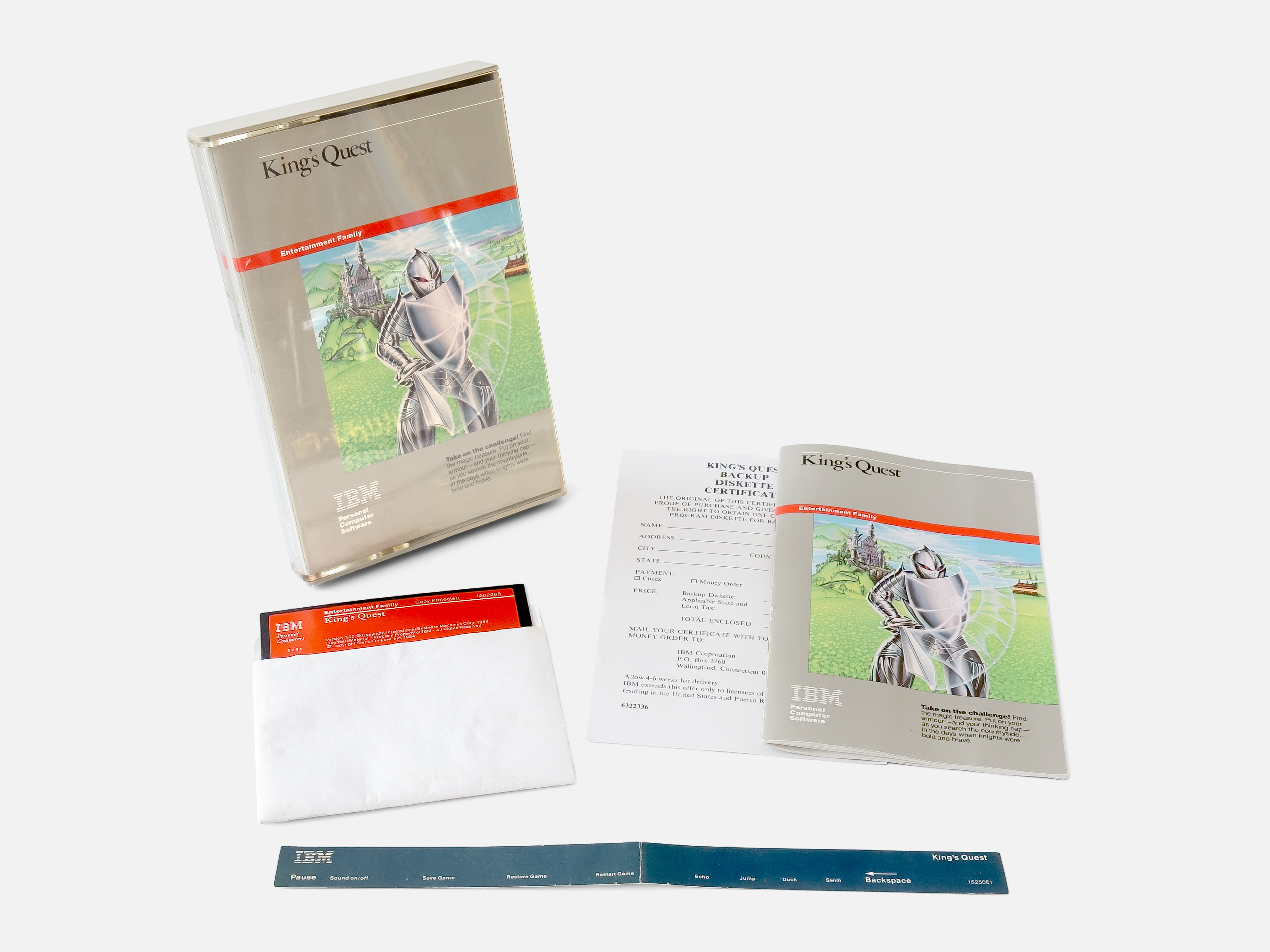






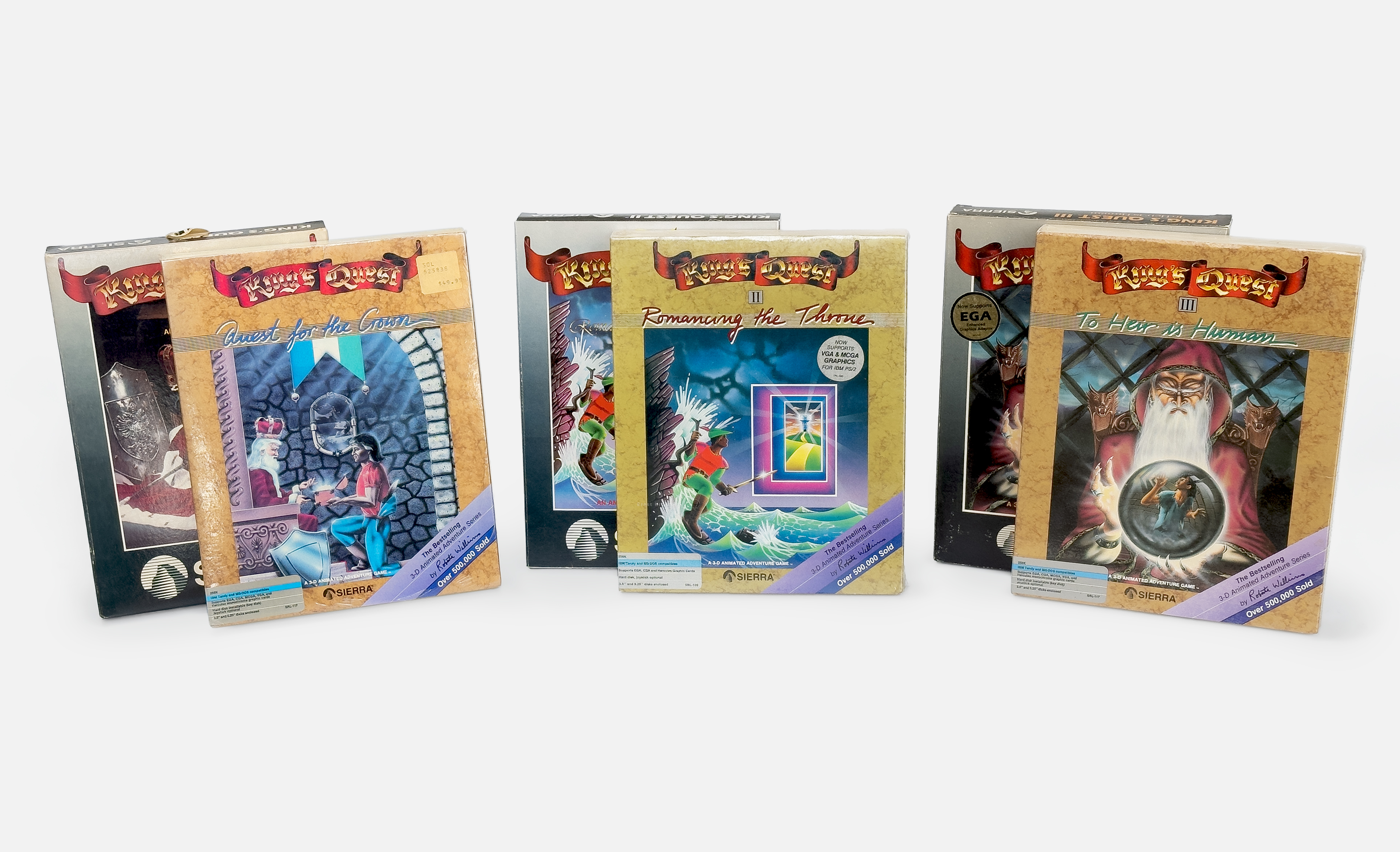
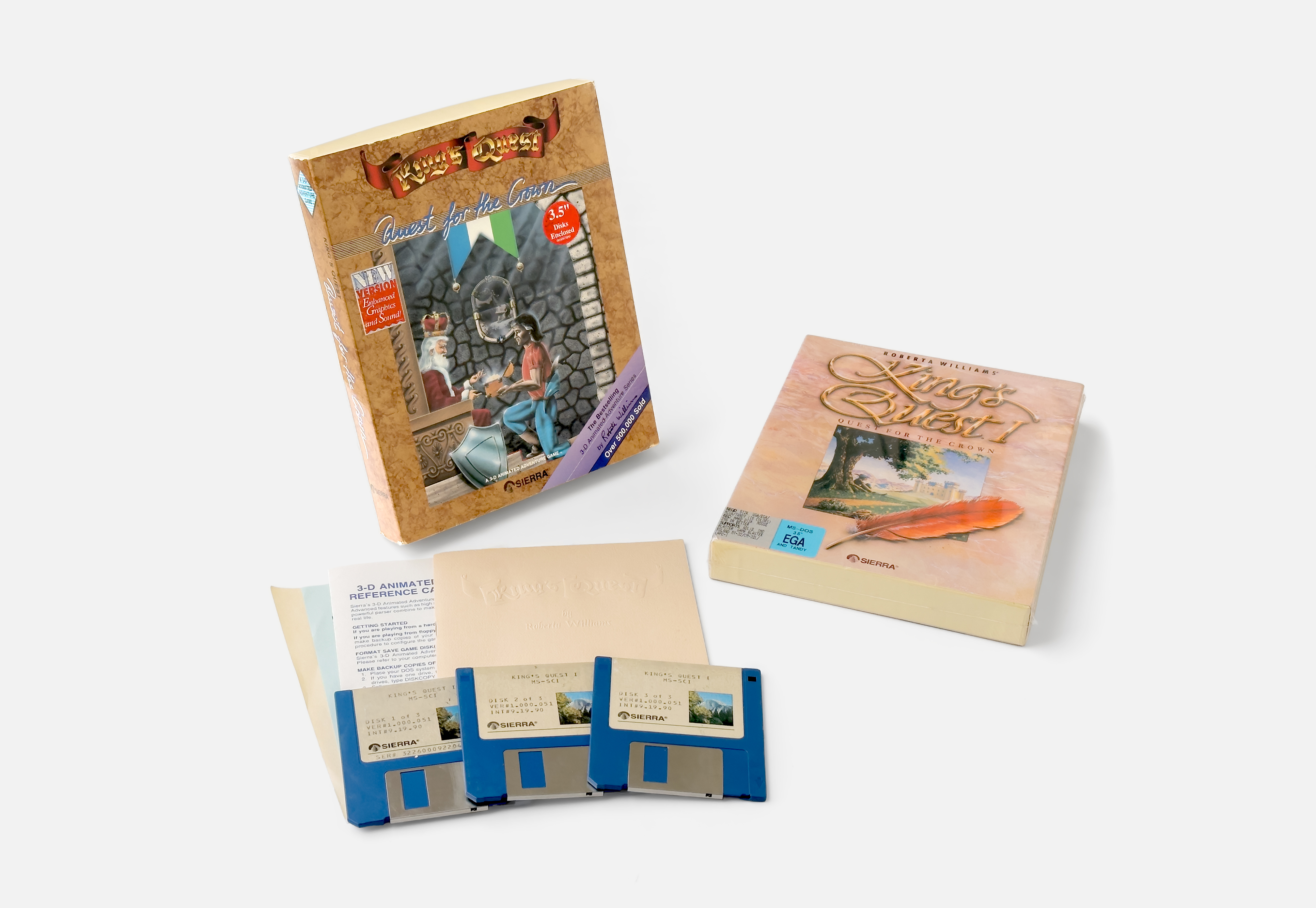



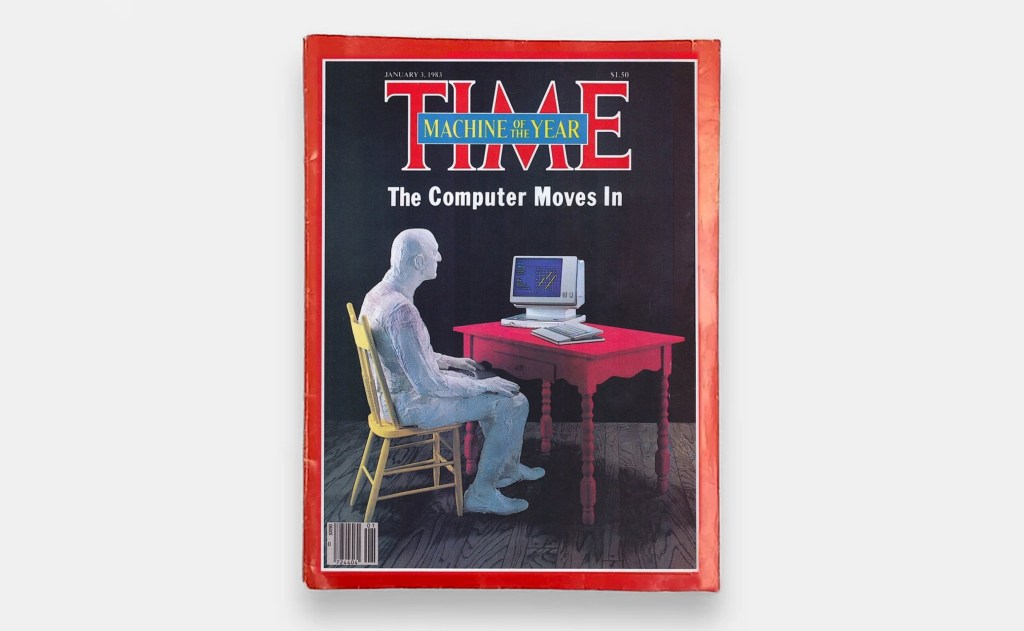

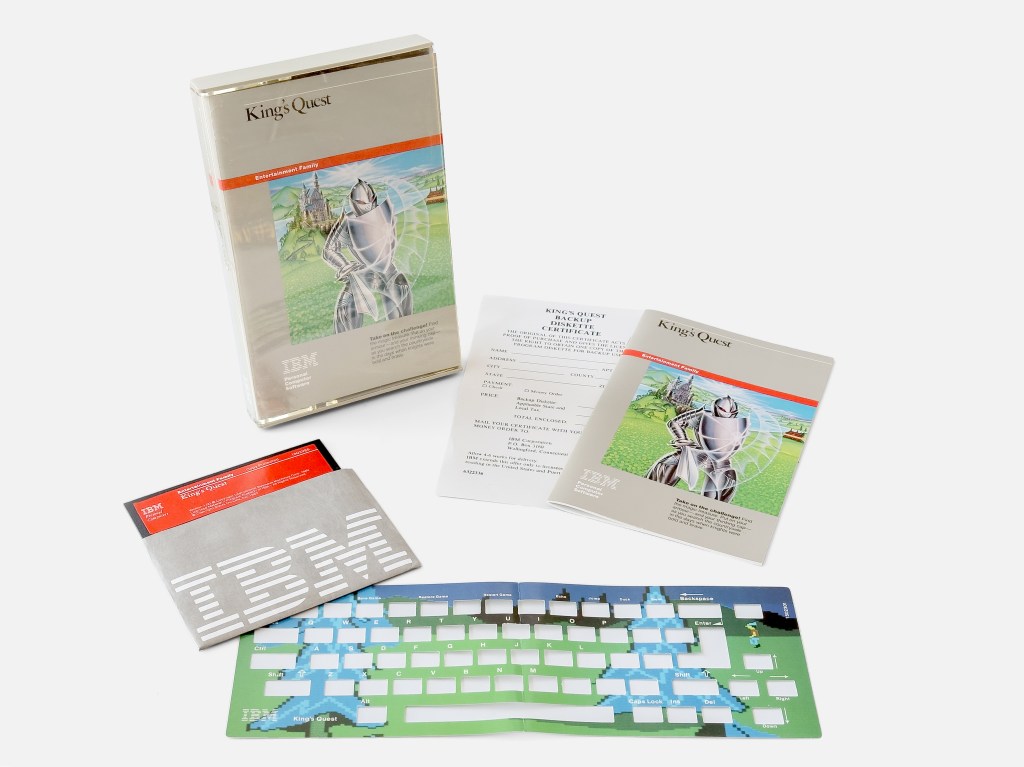

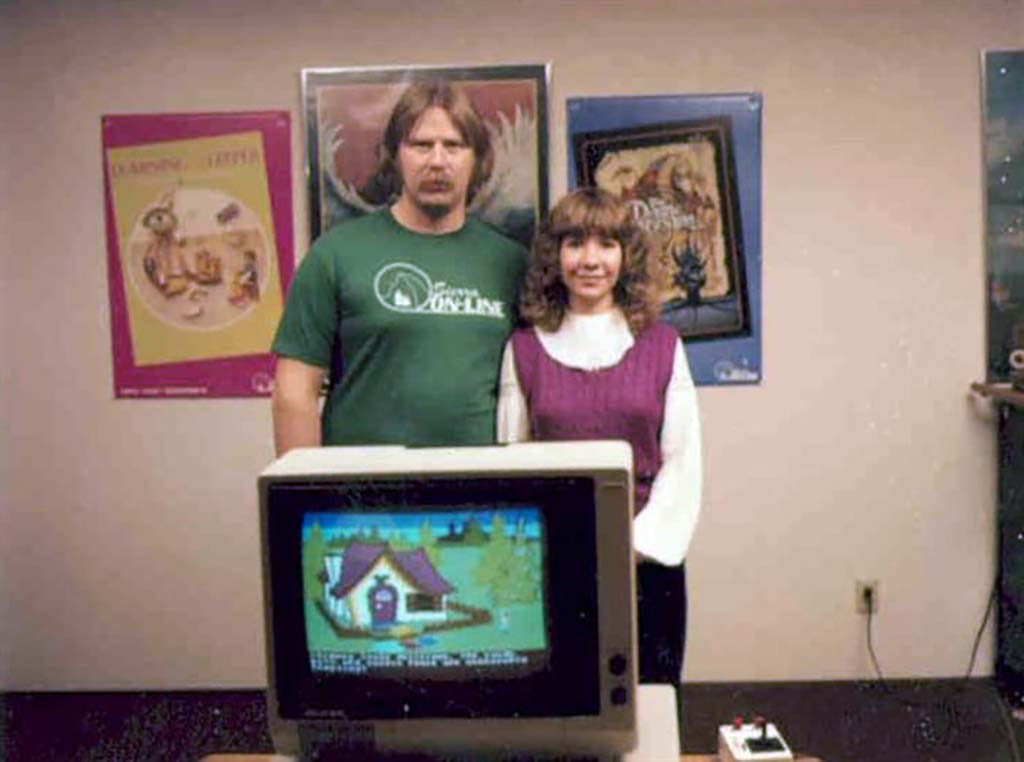


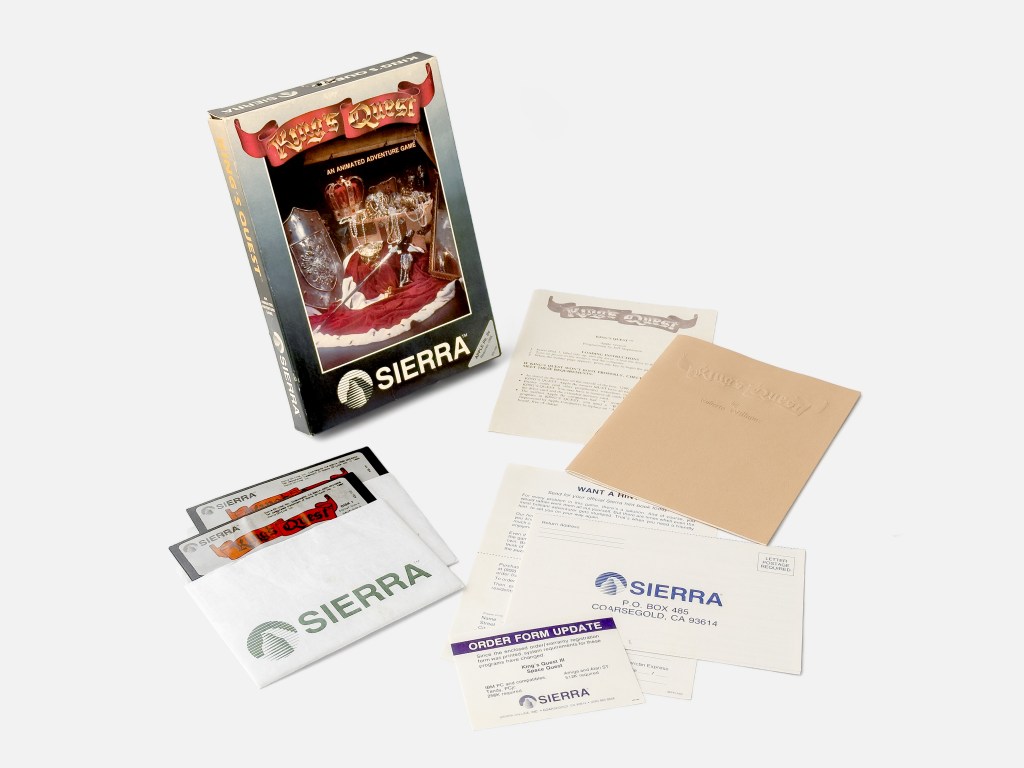

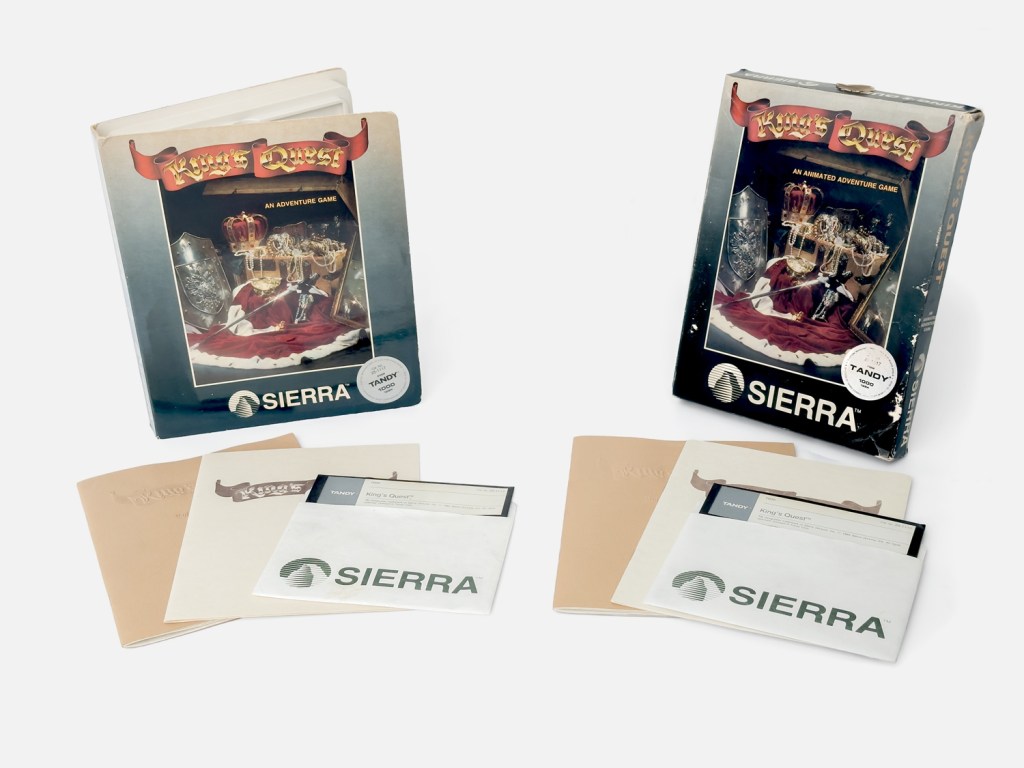


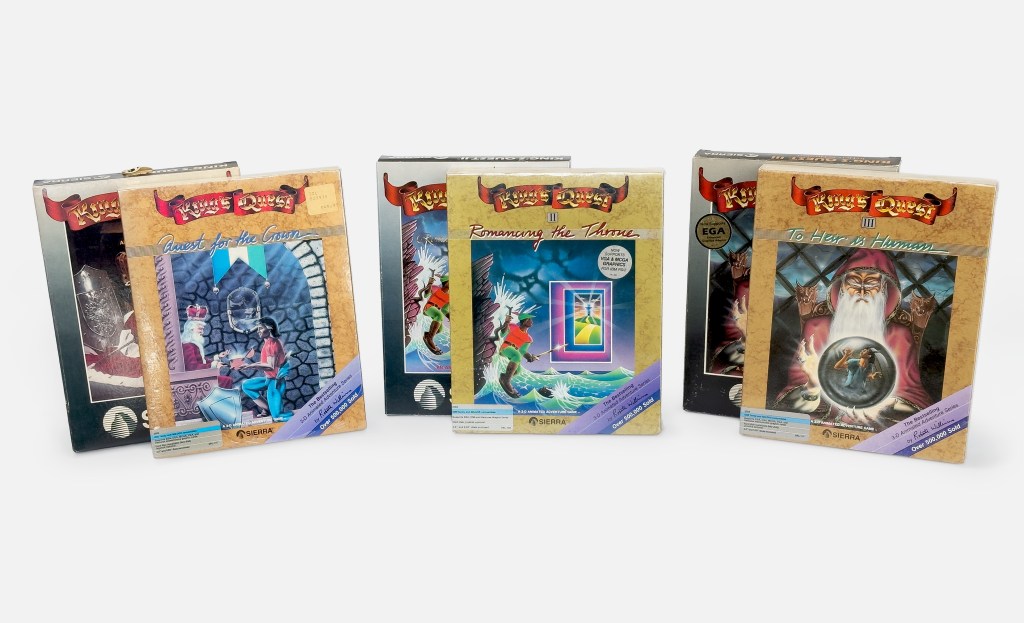

As always, amazing article!! Thank you for all your hard work 🙂
Thank you so much, Yazid:)
Great work! I’m impressed with your research. There was a lot here I had long forgotten.
Thank you so much Ken. Hopefully I got most of it right:)
👏🏻👏🏻👏🏻👏🏻👏🏻 Estupendo artículo!
Gracias:)
Very in depth retrospective of the original King’s Quest. I was familiar with a lot of its history, but there were certainly some new details. The article mentions GAL, which gives me the impression that the original KQ did not use AGI (perhaps that evolved from this game).
My friend had the grey box version of KQ1, but now I’m trying to recall if his version was the clamshell version, or if I’m thinking of another game, such as Mickey’s Space Adventure.
Thanks a lot. Yes, you’re absolutely right about AGI:)
An enjoying read, thanks Ernst!
Thank you so much, glad you enjoyed it:)